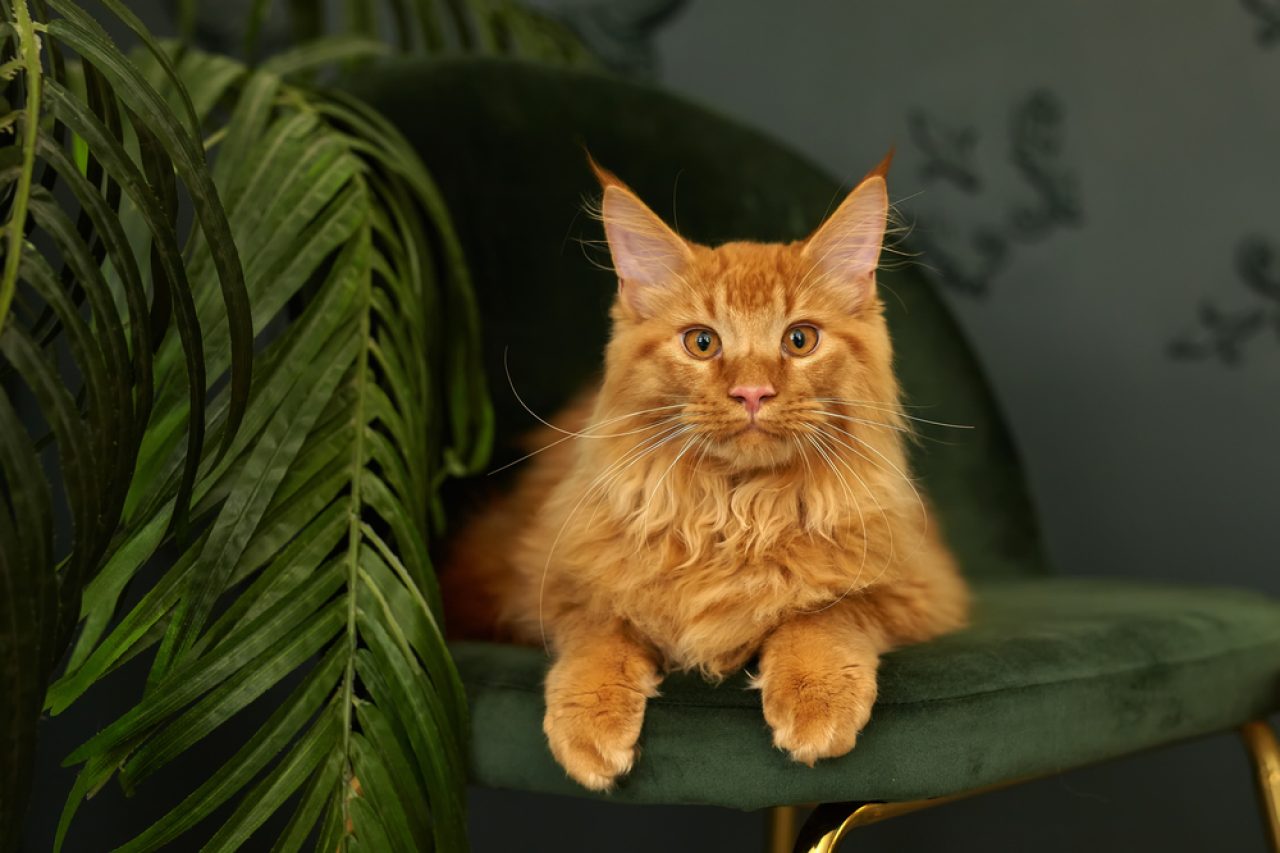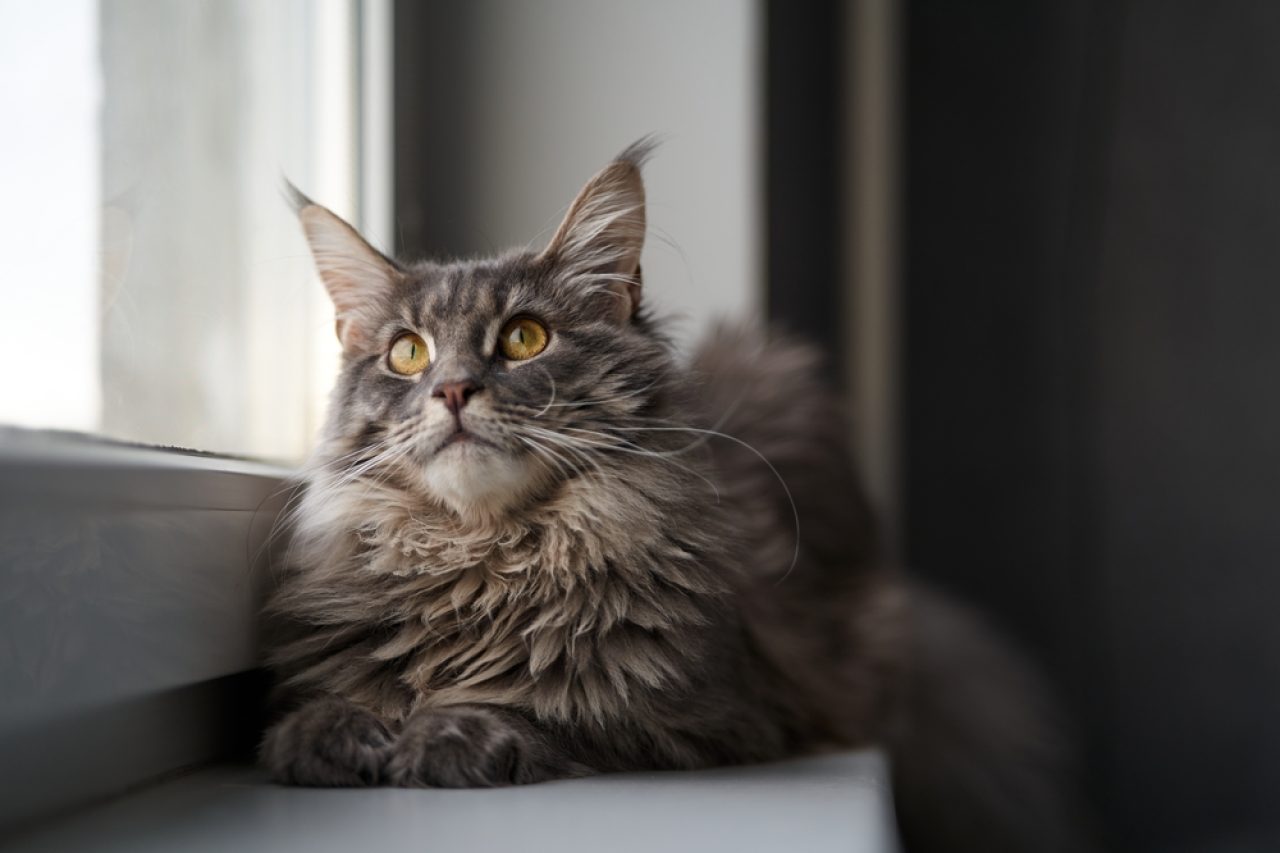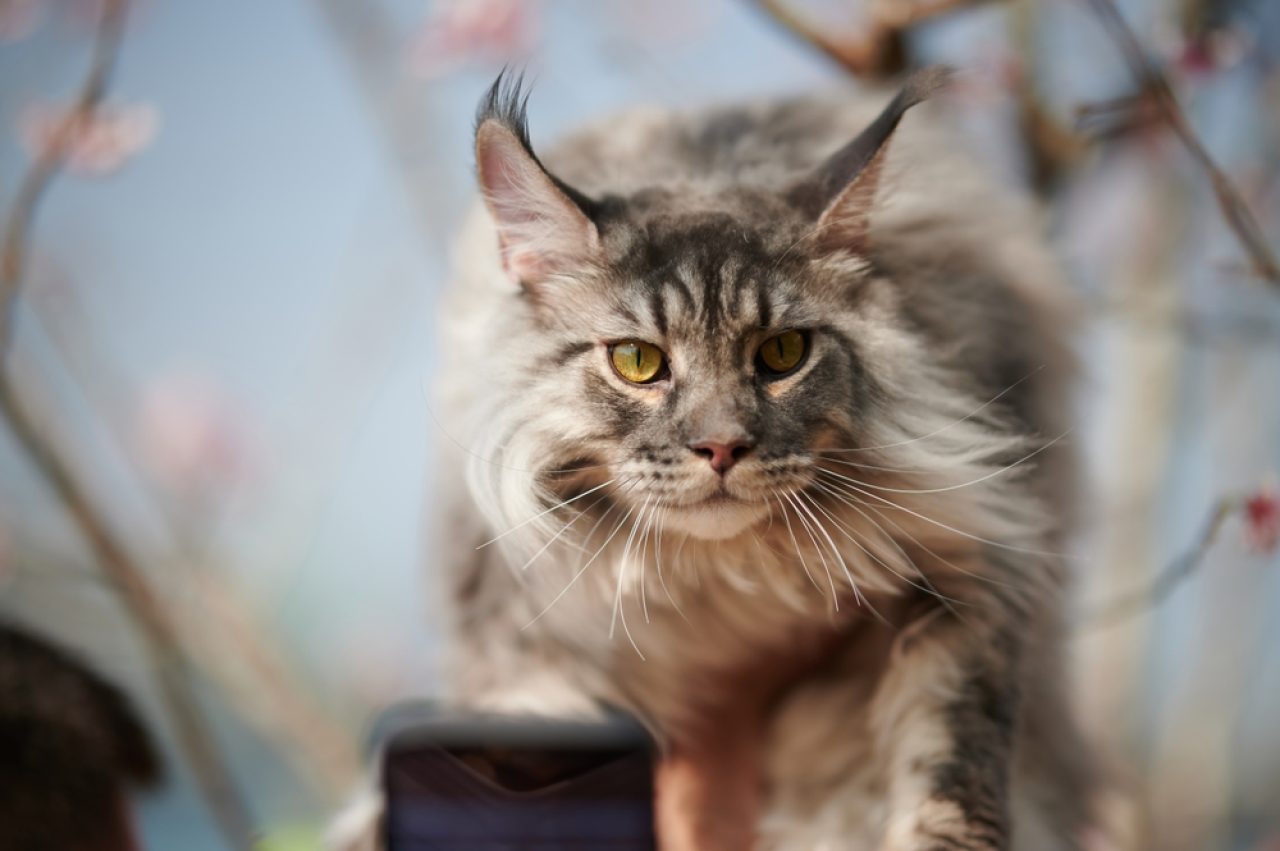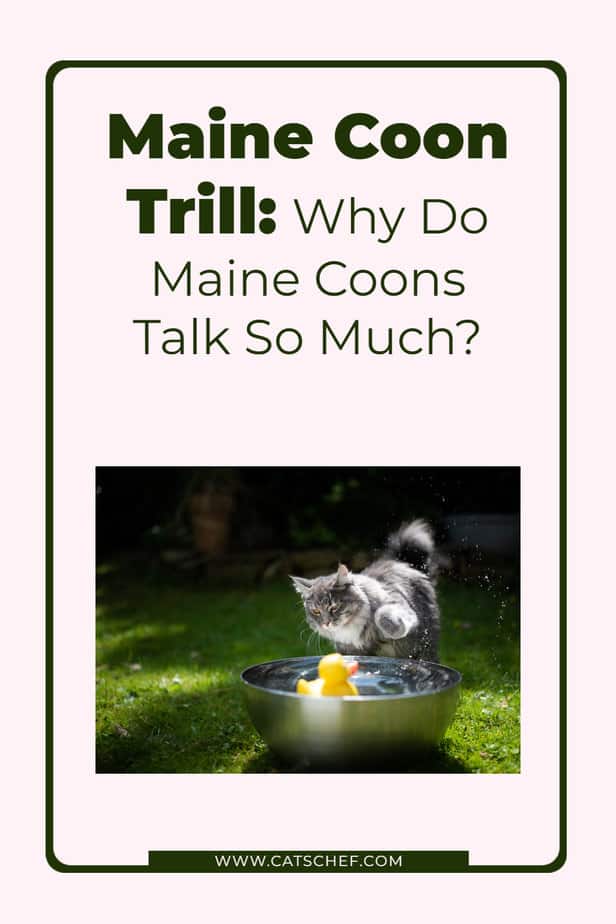Maine Coons are some of the most mesmerizing, mysterious-looking breeds out there. They’re affectionate, appreciative, and adorable. They obsess over humans and love hanging out with them, which makes them the purrfect pets. And, they’re talkative, too – which begs the question of what Maine Coon trills mean.
Truth be told, every pet parent has had that moment of enlightenment where you become convinced your fluffer’s communicating with you.
“I’m telling you, mom,” you scream at the top of your lungs. “She meowed at my questions and she looked like she understood every word I said. She was communicating with me!”
That’s the thing with cats. They’re capable of understanding humans because they learn how to read our body language, our cues, and even our words (when they’re related to food or something that’s of importance to them).
We, on the other hand, aren’t that great at figuring out what each meow, purr, and growl convey. There are times when our fluffers meow and purr when we’re petting them. We assume they’re having fun, but then they scratch our eyes out and storm out of the room.
“What the heck?! She didn’t even flinch when she hurt me!”. We’re not accustomed to observing the bigger picture, but that’s what we’re here to help you with.
Maine Coon cats make a bunch of sounds while they’re going about their business. Other cats might be bigger fans of meowing, but Coons prefer producing chirping, purring, and trilling sounds when they’re communicating emotions.
Throw a glance at what we gathered and become a Coon connoisseur by the end of the article!
What sounds do Maine Coons produce?

Of course, trills aren’t the only sound Maine Coons make on a regular. Coons are a talkative breed that thrives on attention which pretty much spells out why they need an array of sounds to express how they’re feeling. And, sometimes, they’re feeling happy, sad, and angry at the same time.
Now, Coons aren’t that big on purrsonal space which means they spend a lot of time following you from room to room. They expect to become a part of the family from the moment you bring them home. They prefer to spend quality time with you rather than play with other cats or spend time alone.
Considering how friendly Coons are, we’re not surprised they learned to produce different sounds to communicate with humans. Other than trills, Coons often produce different-pitched meows, chirrups, chirps, purrs, hisses, growls, yowls, chatters, snarls, and caterwauls.
Each of these sounds carries a meaning that often depends on other circumstances. Coons are one of the largest domestic breeds and they’re not strangers to employing those long limbs to communicate how they’re feeling.
When you hear a hissing sound paired with flattened ears, downward-facing whiskers, and a hundred back, for example, know that she’s annoyed, aggressive, and ready to attack.
When you hear a purring sound paired with slowly blinking eyes and upward-facing whiskers, on the other hand, know that she’s happy and healthy. Here’s the thing, Maine Coon cats emit sounds as a form of greeting and seeking attention.
Coons, much like other cats, vocalize to express happiness, appreciation, fear, pain, and aggression. However, what are Maine Coon trills and what do they mean?
What are Maine Coon trills?

Maine Coon trills are a sound Coons make with a closed mouth that resembles a meow and a purr (combined). Trills are very, very difficult to discern from other vocalizations because they sound like chirps, chirrups, chatters, and other sounds of contentment.
But, trills are different because your Coon doesn’t open her mouth when she produces them. They’re often a byproduct of purring and occur when your cat feels like she needs something a little louder to get your attention. They’re a form of acknowledgment, greeting, and even appreciation.
Perhaps you noticed your Coon starts making the trilling sound when she greets you at the door after you come home from work. Maybe you caught her making the same sound when you present her with Fancy Feast or other treats. Trilling’s pretty much purring that turns louder when she can’t hide her happiness.
More times than not, trilling communicates positive messages. Coons produce these sounds more often than other breeds, which means you can expect to hear them all the time. Clearly, you need a crash course on the meaning of Maine Coon trills and we’ve got your back.
What do Maine Coon trills mean?
1. She’s looking for attention

Maine Coon trills aren’t that bad, and here’s why. Coons thrive on attention because they love when you give them cuddles and snuggles and spend quality time with them. They’re obsessed with humans, and hanging out with you and your friends can easily become your Coon’s favorite Sunday activity.
However, when your Coon notices you’re not giving her enough attention, she might start producing sounds. While meowing and whining might come first, Coons aren’t above trilling when they’re looking for attention.
When you notice her go from purring to trilling, know that she wants something from you. Are you reading a book? You need to stop that and cuddle her while she’s napping. Are you playing a game? You can’t play a game when she’s bored because you need to do something to entertain her.
Sure, Coons are a high-maintenance breed, but they deserve every bit of attention they get.
2. She’s communicating with her kittens or other cats
Cats are strange creatures that don’t view meowing (and other sounds) as means of communication. As a matter of fact, there are studies showing that cats don’t communicate with other cats with the help of meowing, chirruping, and trilling.
Rather, they communicate through body language and body scents. Cats meow at humans because that’s what gets them the attention they’re looking for. And, cats meow at kittens because they’re tiny and they haven’t learned other means of expressing themselves.
Once they grow older, they get better at communicating through movement. Older cats don’t need to meow at them anymore. On the other hand, Maine Coons are fans of trills and chirrups because they prefer expressing themselves that way.
Sometimes, Coons make trilling sounds at kittens and cats around them because they’re looking for someone to play with or checking whether they have food to share.
3. She’s happy

We’ve mentioned that beforehand, but Maine Coons adore making sounds when they’re happy. For the most part, Coons make trilling sounds when they’re excited about something and they want you to know that.
Coons are an affectionate breed and they’re known for trilling when they’re surrounded by people they love. For example, your Coon might make a trilling sound when you come back home from work or from a long holiday.
Not only do Coons hate spending time alone, but they’re attached to humans and suffer from a sense of abandonment when they’re left alone for longer periods. On the contrary, your Maine Coon cat might start trilling when she wakes up on your bed or when you bring her a packet of her favorite Fancy Feast.
And, we can’t forget about the fact that Coons love hanging out with other members of the cat community. Therefore, your Coon might start trilling when she’s playing with other Coons (or other cats).
4. She’s angry
Maine Coon trills are almost always a sign of comfort, happiness, and contentment. However, we can’t overlook the possibility that your Coon’s producing the same sound when she’s angry, annoyed, or aggressive.
And, there’s a chance you might be mistakingly thinking she’s trilling when she’s actually hissing. Maine Coon cats are friendly which means they don’t cause fights with other cats that often. To tell the truth, they don’t attack humans that often, either.
However, there are times when Maine Coon cats feel stressed out, overwhelmed, and anxious over something. Those are the times when you might catch them producing sounds that are similar to trilling, accompanied by flattened ears, arched backs, and fluffed-up tails.
That means that they’re thinking of attacking you or running away, and you’re better off keeping a safe distance and waiting for them to calm down. Don’t worry, that doesn’t happen as frequently with Coons as does with other cats.
5. She’s hungry

Well, this one is no surprise! Maine Coon cats might not be aggressive when they’re playing with other cats, but they can appear aggressive when they’re hungry.
Coons are famous for the fact that they love food more than anything (and which cat doesn’t?), and they resort to plenty of sounds when they want you to feed them.
Now, Maine Coon trills are common when you haven’t remembered to feed your Coon for the past couple of hours and she’s already plotting your murder. But, they’re common when your Coon catches a glimpse of you munching on your lunch or getting ready to feed her, too.
Hence, when you notice your Coon pacing around an empty food bowl and trilling her little heart away, she’s probably hungry. Make sure you feed her on time – but, don’t succumb to her pouty snout and her melodious chimes when you know she finished eating three minutes ago.
6. She’s saying “Hello!”
Who wouldn’t be happy to come home from work and be greeted by an adorable, purring machine waiting to cuddle and snuggle the tiredness away? Maine Coons trill whenever they’re happy or excited, and they go through all those emotions when they see your face.
Trust me, these trills are a Coon’s way of saying “Hello! I missed you!” Even when she keeps making the same sound every time she enters the room, catches you staring at her, or hears you talking to her about your day. Coons are particularly obsessed with trilling. Of course, that’s why you keep hearing the same sound over and over.
What sounds should you produce back at your Maine Coon?

Maine Coon trills and other sounds Maine Coons make are a great way to understand what they’re trying to communicate. However, there are times when you can’t help but wonder whether you should produce the same sounds back. Come on, how many times have you tried meowing at your cat?
Turns out cats adore when you try to speak the same way they do! Not only that, but cats love listening to you ranting about your day and asking them for advice (that’s when you get a little trill). Not to mention that Coons are talkative and expect you to talk back at them.
Don’t shy away from talking to them the same way you would to a baby. And, don’t dodge the possibility of making the same sounds she makes – that’s a great way of bonding with your Coon. However, evade making sounds that could trigger her aggression.
Some of the sounds cats hate to hear are balloons, lawnmowers, and even humans humming. Other than that, prepare a cup of coffee for you and a treat for your Coon, and get to bonding.

